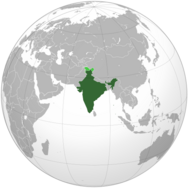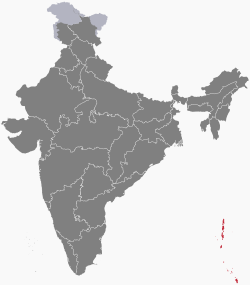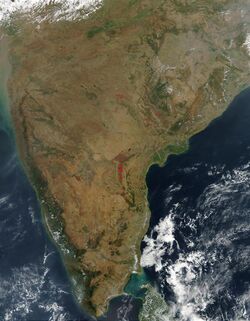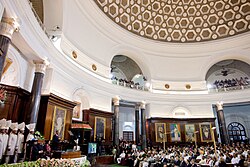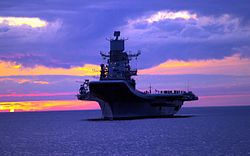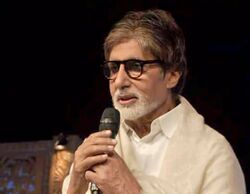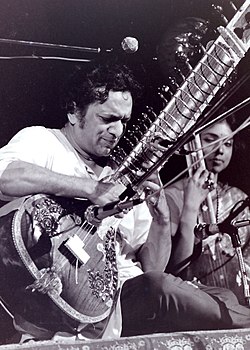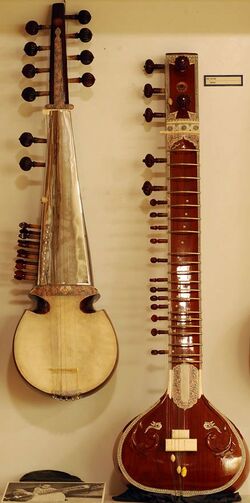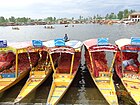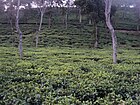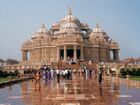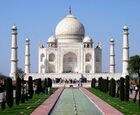Outline of India
Topic: Place
 From HandWiki - Reading time: 13 min
From HandWiki - Reading time: 13 min
The following outline is provided as an overview of, and topical guide to, India :
The seventh-largest country by area, India is located on the Indian subcontinent in South Asia. India was home to the ancient Indus Valley civilisation, and is the birthplace of four world religions: Hinduism, Sikhism, Buddhism, Jainism. India endured colonisation, eventually being administered by the United Kingdom from the mid-19th century to the mid-20th century. India became an independent nation in 1947 after a struggle for independence led by influential figures like Mahatma Gandhi, Subash Chandra Bose and underwent a violent partition. India (as of April 2023) is the most populous country with over 1.4 billion people, and is also the most populous democracy in the world.
General reference
- Pronunciation: /ˈɪndiə/
- Common English country name: India
- Official English country name: The Republic of India
- Common endonym(s): Bharat, Hindustan
- Official endonym(s): Bharat Ganarajya
- Adjectival(s): Indian
- Demonym(s): Indian
- Etymology: Names of India
- International rankings of India
- ISO country codes:IN, IND, 356
- ISO region codes:See IN
- Internet country code top-level domain:.in
Geography of India
- India is:
- a subcontinent
- a country
- Location:
- Eastern Hemisphere
- Northern Hemisphere
- Time zone: Indian Standard Time (30)
- Extreme points of India
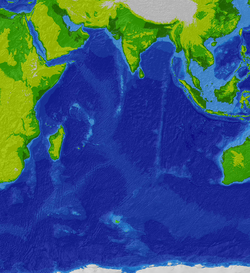
- High: Kangchenjunga 8,586 m (28,169 ft) – third highest peak on Earth
- Low: Kuttanad −2.2 m (−7 ft)
- Land boundaries: 14,103 km
 Bangladesh 4,053 km
Bangladesh 4,053 km China 3,380 km including the territorial disputes along its border; McMahon Line
China 3,380 km including the territorial disputes along its border; McMahon Line Pakistan including the Line of Control 2,912 km
Pakistan including the Line of Control 2,912 km Nepal 1,690 km
Nepal 1,690 km Myanmar 1,463 km
Myanmar 1,463 km Bhutan 605 km
Bhutan 605 km Afghanistan 106 km
Afghanistan 106 km
- Coastline: 7,000 km
- Indian Ocean
- Arabian Sea
- Bay of Bengal
- Population of India: 1,210,193,422 people (2011 census) – 2nd most populous country
- Census of India
- Area of India:3,287,263 km2 (1,269,219 sq mi) – 7th largest country
- Subcontinent (Indian subcontinent)
- Atlas of India
Environment of India
- Climate of India
- Climate change in India
- Environmental issues in India
- Ecoregions of India
- Renewable energy in India
- Solar power in India
- Wind power in India
- Geology of India
- National parks of India
- List of mountains in India/Orography of India
- Protected areas of India
- Wildlife of India
- Flora of India
- Fauna of India
- Birds of India
- Mammals of India
Geographic features of India
- North India
- East India
- South India
- West India
- Central India
- Northeast India
- Extreme points of India
- Beaches of India
- Glaciers of India
- Islands of India
- Lakes of India
- Mountains of India
- Volcanoes of India
- Rivers of India
- Waterfalls of India
- Valleys of India
- List of World Heritage Sites in India
Physical divisions of India
- The northern mountains including the Himalaya s, which includes the Karakoram ranges and the northeast mountain ranges.
- Indo-Gangetic plains
- Thar Desert
- Central Highlands and Deccan Plateau
- Eastern coastal plains
- Western coastal plains
- Bordering seas and islands
Administrative divisions of India
Administrative divisions of India
Administrative divisional structure of India
| Structure of administrative divisions in India | ||||||||||||||||||||||||||||||||||||||||||||||||||||||||||||||||||||||||||||||||||||||||||||||||||||||||||||||||||||||||||||||||||||||||||||||||||||||||||||||||||||||||||||||||||||||||||||||||||||||||||||||||||||||||||||||||||||||||||||||||||||||||||||||||||||||||||||||||||||||||||||||||||||||||||||||||||||||||||||||||||||||
|---|---|---|---|---|---|---|---|---|---|---|---|---|---|---|---|---|---|---|---|---|---|---|---|---|---|---|---|---|---|---|---|---|---|---|---|---|---|---|---|---|---|---|---|---|---|---|---|---|---|---|---|---|---|---|---|---|---|---|---|---|---|---|---|---|---|---|---|---|---|---|---|---|---|---|---|---|---|---|---|---|---|---|---|---|---|---|---|---|---|---|---|---|---|---|---|---|---|---|---|---|---|---|---|---|---|---|---|---|---|---|---|---|---|---|---|---|---|---|---|---|---|---|---|---|---|---|---|---|---|---|---|---|---|---|---|---|---|---|---|---|---|---|---|---|---|---|---|---|---|---|---|---|---|---|---|---|---|---|---|---|---|---|---|---|---|---|---|---|---|---|---|---|---|---|---|---|---|---|---|---|---|---|---|---|---|---|---|---|---|---|---|---|---|---|---|---|---|---|---|---|---|---|---|---|---|---|---|---|---|---|---|---|---|---|---|---|---|---|---|---|---|---|---|---|---|---|---|---|---|---|---|---|---|---|---|---|---|---|---|---|---|---|---|---|---|---|---|---|---|---|---|---|---|---|---|---|---|---|---|---|---|---|---|---|---|---|---|---|---|---|---|---|---|---|---|---|---|---|---|---|---|---|---|---|---|---|---|---|---|---|---|---|---|---|---|---|---|---|---|---|---|---|---|---|---|---|---|---|---|---|---|---|---|---|---|---|---|---|---|---|---|---|---|---|---|---|
| ||||||||||||||||||||||||||||||||||||||||||||||||||||||||||||||||||||||||||||||||||||||||||||||||||||||||||||||||||||||||||||||||||||||||||||||||||||||||||||||||||||||||||||||||||||||||||||||||||||||||||||||||||||||||||||||||||||||||||||||||||||||||||||||||||||||||||||||||||||||||||||||||||||||||||||||||||||||||||||||||||||||
States and union territories of India
| 1. Andhra Pradesh | 13. Madhya Pradesh | 25. Tripura |
| 2. Arunachal Pradesh | 14. Maharashtra | 26. Uttar Pradesh |
| 3. Assam | 15. Manipur | 27. Uttarakhand |
| 4. Bihar | 16. Meghalaya | 28. West Bengal |
| 5. Chhattisgarh | 17. Mizoram | A. Andaman and Nicobar Islands |
| 6. Goa | 18. Nagaland | B. Chandigarh |
| 7. Gujarat | 19. Odisha | C. Dadra and Nagar Haveli and Daman and Diu |
| 8. Haryana | 20. Punjab | D. Jammu and Kashmir |
| 9. Himachal Pradesh | 21. Rajasthan | E. Ladakh |
| 10. Jharkhand | 22. Sikkim | F. Lakshadweep |
| 11. Karnataka |
23. Tamil Nadu | G. Delhi |
| 12. Kerala | 24.Telangana | H. Puducherry |
States and union territories of India
- Autonomous regions of India
- Emblems of Indian states
- States and union territories of India
- By name
- States by name
- Andhra Pradesh (outline)
- Arunachal Pradesh (outline)
- Assam (outline)
- Bihar (outline)
- Chhattisgarh (outline)
- Goa (outline)
- Gujarat (outline)
- Haryana (outline)
- Himachal Pradesh (outline)
- Jharkhand (outline)
- Karnataka (outline)
- Kerala (outline)
- Madhya Pradesh (outline)
- Maharashtra (outline)
- Manipur (outline)
- Meghalaya (outline)
- Mizoram (outline)
- Nagaland (outline)
- Odisha (outline)
- Punjab (outline)
- Rajasthan (outline)
- Sikkim (outline)
- Tamil Nadu (outline)
- Telangana (outline)
- Tripura (outline)
- Uttar Pradesh (outline)
- Uttarakhand (outline)
- West Bengal (outline)
- Union territories by name
- Andaman and Nicobar Islands
- Chandigarh
- Dadra and Nagar Haveli and Daman and Diu
- Delhi
- Jammu and Kashmir
- Ladakh
- Lakshadweep
- Puducherry
- States by name
- By rank
- By economic rank
- By various rankings
- By population
- By population density
- By size
- By state code
- By name
- State and territory capitals
Divisions of India
Municipalities of India
Municipalities of India
- Cities in India
- National Capital of India: New Delhi
- Financial Capital of India: Mumbai
- Cultural Capital of India: Kolkata
- Manchester of India: Ahmedabad
- City of Diamond: Surat
- Detroit of Asia: Chennai
- Milk city of India: Anand
- Silicon Valley of India: Bangalore
- Ceramic Capital of India: Morbi
- City of Nawabs: Lucknow
- Pink City of India: Jaipur
- Big cities in North East India
- List of city and town nicknames in India
- Million-plus cities in India
- Most populous cities in India
Geography of states and territories
Demography of India
Demographics of India
- Ethnic groups of India
- Racial groups of India
- Religion of India
Demographics of states and territories
Government and politics of India
- Form of government: Sovereign socialist secular federal parliamentary multi-party representative democratic republic.
- Sovereign – this means an independent nation.
- Socialist – this implies social and economic equality for all Indian citizens. This guarantees equal opportunity and equal social status. The government attempts to reduce economic inequality by reducing concentration of wealth.
- Secular – practices separation of religion and state. This implies freedom to choose one's religion. The state gives every citizen the right to practice and propagate a religion of his choice, and also right to reject all religions. The state treats all religions as equal and there is no official state religion.
- Democratic – this means the government is democratically elected, and the head of the government (prime minister) is elected by the people.
- Republic – this means the head of the state (president) is not a hereditary monarch but indirectly elected by the people.[1]
- Capital of India: New Delhi
- Elections in India
- 1951 | 1957 | 1962 | 1967 | 1971 | 1977 | 1980 | 1984 | 1989 | 1991 | 1996 | 1998 | 1999 | 2004 | 2009 | 2014 | 2019
- Political parties in India
- Aam Aadmi Party

- All India Trinamool Congress

- Bahujan Samaj Party
- Bharatiya Janata Party

- Communist Party of India

- Communist Party of India (Marxist)

- Dravidian parties

- Dravida Munnetra Kazhagam

- All India Anna Dravida Munnetra Kazhagam

- Pattali Makkal Katchi

- Marumalarchi Dravida Munnetra Kazhagam

- Naam Tamilar Katchi
- Desiya Murpokku Dravida Kazhagam
- Dravida Munnetra Kazhagam
- Indian National Congress

- Janata Dal (United)

- Maharashtra Navnirman Sena

- Nationalist Congress Party

- Samajwadi Party
- Shiromani Akali Dal

- Shivsena

- Rashtriya Janata Dal

- Telugu Desam Party
- Bharat Rashtra Samithi

- Yuvajana Sramika Rythu Congress Party YSRCP

- Aam Aadmi Party
- Political scandals in India
- Taxation in India
Socio-economic issues in India
- Religious violence in India
- Katchatheevu Issue
- Religious tolerance in India
- Terrorism in India
- Naxalism
- Caste system in India
- Caste politics in India
- Caste-related violence in India
- Reservation in India
- Human rights in India
- LGBT rights in India
- Freedom of religion in India
Branches of the government of India
Executive of the government of India
- Head of state: President of India
- Vice-President of India
- The Cabinet
- Head of government: Prime Minister of India
- Head of the civil services: Cabinet Secretary of India
Legislature of the government of India
- Parliament of India
- Rajya Sabha (Council of States) – upper house of the parliament (Vice-President of India serves as the Chairman of the Rajya Sabha)
- Lok Sabha (House of the People) – lower house of the parliament (Speaker)
Judiciary of the government of India
- Supreme Court of India (Chief Justice of India)
- List of high courts in India
- District Courts of India
Foreign relations of India
International organisation membership
The Republic of India is a member of:[2]
Law and order in India
- Cannabis in India
- Capital punishment in India
- Company Law in India
- Indian Contract Act, 1872
- Constitution of India
- Basic Structure
- Directive Principles
- Fundamental Rights
- Fundamental Duties
- Criminal Law in India
- Indian Penal Code
- Code of Criminal Procedure (India)
- Indian tort law
- Property Law in India
- Crime in India
- Bride burning
- Organised crime in India
- Eve teasing
- Female foeticide in India
- Rape in India
- 2012 Delhi gang rape case
- Directive Principles in India
- Dowry law in India
- Fundamental Rights in India
- History of Indian law
- Law enforcement in India
- Nationality Law in India
- Labour Law in India
- List of prisons in India
- Prisons in India
National law enforcement agencies
- Ministry of Home Affairs (Minister of Home Affairs • Home Secretary)
All India Service for policing — Indian Police Service
- Border Security Force
- Central Bureau of Investigation
- Central Industrial Security Force
- Central Reserve Police Force
- Defence Security Corps
- Directorate of Revenue Intelligence
- Indian Coast Guard
- Indo-Tibetan Border Police
- National Security Guards
- Railway Protection Force
- Special Protection Group
- Narcotics Control Bureau
State police forces
Armed forces of India
- Command
- Commander-in-chief: President of India
- Ministry of Defence of India
- Minister of Defence
- Defence Secretary
- Strategic Nuclear Command
- Strategic Forces Command
- Chief of Army Staff of the Indian Army
- Chief of Naval Staff of the Indian Navy
- Chief of Air Staff of the Indian Air Force
- Minister of Defence
- Ministry of Defence of India
- Commander-in-chief: President of India
- Forces
- Army: Indian Army
- Army ranks and insignia of India
- Navy: Indian Navy
- Naval ranks and insignia of India
- Indian Ocean Naval Symposium (website)
- Air Force : Indian Air Force
- Air Force ranks and insignia of India
- Indian Coast Guard
- Special forces: Special Forces of India
- Indian Peace Keeping Force
- Paramilitary forces of India
- National Security Guard
- Special Protection Group
- Army: Indian Army
- Military academies in India
- India and weapons of mass destruction
- Integrated Guided Missile Development Program
Government of states
- Governor
- Chief minister
- Chief secretary
- Vidhan Sabha
- Vidhan Parishad
- Zilla Parishad
- Panchayati Raj
Politics by states and territories
History of India
History of India by period
- Prehistoric India
- Riwatian people (1,900,000 BC)
- Soanian people (500,000 BC)
- South Asian Stone Age (70,000–3300 BCE)
- Ancient India (outline)
- Ancient Indian cities
- Indus Valley civilization (3300–1700 BCE)
- Late Harappan culture (1700–1300 BCE)
- Vedic period (1700–500 BCE)
- Iron Age (1200–300 BCE)
- Mahajanapadas (700–300 BCE)
- Magadha Empire
- Haryanka dynasty (684–413 BCE)
- Shishunaga dynasty (413–345 BCE)
- Nanda dynasty (424–321 BCE)
- Maurya Empire (322- 185 BCE)
- Middle kingdoms of India (250 BCE–1279 CE)
- Chola Empire (250 BCE–1070 CE)
- Satavahana (230 BCE–220 CE)
- Shunga Empire (185–75 BCE)
- Kushan Empire (60–240 CE)
- Gupta Empire (280–550 CE)
- Pala Empire (750–1174 CE)
- Rashtrakuta (753–982 CE)
- Islamic empires in India (1206–1596)
- Delhi Sultanate (1206–1596)
- Deccan Sultanates(1490–1596)
- Hoysala Empire (1040–1346)
- Ahom Kingdom (1228–1826)
- Vijayanagara Empire (1336–1646)
- Mughal Empire (1526–1858)
- Maratha Empire (1674–1818)
- Colonial India (1858–1947)
- British Raj
- Princely states
- Indian independence movement
- Quit India Movement
- Partition of India (1947)
- History of Republic of India (1947–present)
History of India by region
History of India by subject
- Economic history of India
- Economy of India under the British Raj
- History of Buddhism in India
- History of clothing in India
- History of education in the Indian subcontinent
- History of Hinduism
- History of Indian archaeology
- History of Indian football
- History of the India national football team
- History of Indian influence on Southeast Asia
- History of Indian Institutes of Technology
- History of railways in India
- History of sex in India
- History of the Indian cricket team
- History of the rupee
- Indian maritime history
- Indian natural history
- LGBT history in India
- Linguistic history of India
- List of massacres in India
- Military history of India
- History of the Indian Air Force
- Peopling of India
- Science and technology in ancient India
- Slavery in India
- Timeline of major famines in India during British rule
- History of Dravidian people
Culture of India
- Caste system in India
- Indian dress
- Festivals in India
- Humour in India
- Media in India
- National symbols of India
- Coat of arms of India
- Flag of India
- National anthem of India
- Public holidays in India
- Religion in India
- Hinduism in India
- Dravidian in India
- Islam in India
- Buddhism in India
- Christianity in India
- Judaism in India
- Jainism in India
- Sikhism in India
- Zoroastrianism in India
- Baháʼí Faith in India
- World Heritage Sites in India
Cuisine of India
- Main dishes
- Sweets and desserts
- Drinks
- Snacks
- Spices
- Condiments
- History
- Supermarket chains in India
- Fast food
Cuisine by regions
|
|
|
|
The arts in India
- Art in India
- Comics in India
- Webcomics in India
- Television in India
- Theatre in India
- Indian classical dance
- Dance forms of Andhra Pradesh
Architecture of India
- Hindu temple architecture
- Buddhist architecture
- Indian rock-cut architecture
- Indian vernacular architecture
- Dravidian Architecture
- Hemadpanthi
- Western Chalukya Architecture
- Badami Chalukya Architecture
- Rajasthani architecture
- Architecture of Karnataka
- Architecture of Bengal
- Hoysala architecture
- Vijayanagara architecture
- Kalinga Architecture
- Maratha Architecture
- Mughal architecture
- Indo-Islamic architecture
- Indo-Saracenic Revival architecture
- Chandigarh
- List of Indian architects
Cinema of India
- Lists of Indian films
- List of Indian documentary films
- List of highest-grossing Bollywood films
- List of Bhojpuri films
- List of Marathi films
- List of Assamese films
- List of Tamil-language films
- List of Telugu-language films
- List of Malayalam films
- List of Kannada films
- List of Bengali films
- List of Indian film actresses
- List of Indian film actors
- List of Indian film directors
- List of Indian film choreographers
- List of Indian film cinematographers
- List of Indian film score composers
- List of film festivals in India
- List of Indian film producers
- List of Indian film screenwriters
Film Awards
- National Film Awards
- Filmfare Awards
- Stardust Awards
- Star Screen Awards
- Bollywood Movie Awards
- Global Indian Film Awards
- IIFA Awards
- Zee Cine Awards
- Nandi Awards
- Karnataka State Film Awards
Cinema by region
Music of India
- Indian classical music
- Hindustani classical music
- Carnatic classical music
- Indian folk music
- Bhavageete
- Bhangra (music)
- Pandavani
- Lavani
- Dandiya
- Baul music
- Qawwali
- Indian pop
- Indian hip hop
- Filmi
- Indian rock
- Sangeet Natak Akademi
- Thyagaraja Aradhana
- Cleveland Thyagaraja Aradhana
- Chembai sangeetha utsavam
- List of Indian playback singers
- Indian musical instruments
Music by states and territories
Literature of India
- List of Indian poets
- List of Indian authors
- Indian epic poetry
- Jnanpith award
- Sahitya Akademi Award
- Indian Literature (journal)
- Indian folklore
Literature by language
Languages in India
Sports in India
- India at the Olympics
- India at the Commonwealth Games
- India at the Asian Games
- India at the Lusofonia Games
- Traditional sports of India
- Wrestling in India
- Field hockey in India
- Cricket in India
- Football in India
- Kabaddi
- Rugby in India
- Indian martial art
- Sports in Delhi
Major Sports Leagues
- Hockey India League (Hockey)
- Indian Premier League (Cricket)
- I-League (Football)
- Indian Super League (Football)
- Indian Badminton League (IBL) (Badminton)
- Pro Kabaddi (Kabaddi)
- Ultimate Table Tennis (Table Tennis
- Ultimate Kho Kho (Kho-Kho)
Culture by region
Economy and infrastructure of India
- Economic rank, by nominal GDP (2011): 9th (twelfth)
|
|
|
Economy & infrastructure of states
Education in India
Education in states
Tourism in India
Tourist attractions
|
|
Tourism in states
List of tourism in different states of India
See also
 India
India
- List of international rankings
- Member state of the Commonwealth of Nations
- Member state of the Group of Twenty Finance Ministers and Central Bank Governors
- Member state of the United Nations
- Outline of Asia
- Outline of geography
| Assamese language edition of Wikipedia, the free encyclopedia |
| Bengali language edition of Wikipedia, the free encyclopedia |
| Bhojpuri language edition of Wikipedia, the free encyclopedia |
| Gujarati language edition of Wikipedia, the free encyclopedia |
| Hindi language edition of Wikipedia, the free encyclopedia |
| Kannada language edition of Wikipedia, the free encyclopedia |
| Kashmiri language edition of Wikipedia, the free encyclopedia |
| Konkani language edition of Wikipedia, the free encyclopedia |
| Maithili language edition of Wikipedia, the free encyclopedia |
| Malayalam language edition of Wikipedia, the free encyclopedia |
| Marathi language edition of Wikipedia, the free encyclopedia |
| Nepali language edition of Wikipedia, the free encyclopedia |
| Oriya language edition of Wikipedia, the free encyclopedia |
| Punjabi language edition of Wikipedia, the free encyclopedia |
| Sanskrit language edition of Wikipedia, the free encyclopedia |
| Sindhi language edition of Wikipedia, the free encyclopedia |
| Tamil language edition of Wikipedia, the free encyclopedia |
| Telugu language edition of Wikipedia, the free encyclopedia |
| Tulu language edition of Wikipedia, the free encyclopedia |
| Urdu language edition of Wikipedia, the free encyclopedia |
References
- ↑ "India Government, Indian Democracy | India Quick Facts". http://www.indiaquickfacts.com/content/india-government-indian-democracy.
- ↑ "India". United States Central Intelligence Agency. 13 July 2009. https://www.cia.gov/the-world-factbook/countries/india/.
External links
- Government
- Official entry portal of the Government of India
- Official directory of Indian Government websites
- General reference
- India. The World Factbook. Central Intelligence Agency.
- Encyclopædia Britannica entry on India
- BBC country profile of India
- Library of Congress Country Studies entry on India
- Other
- Incredible India – The Official Tourism Website of Ministry of Tourism, Government of India
- Ministry of Petroleum and Natural Gas
- India at Curlie
- India 4You – Directory of popular Indian websites.
 KSF
KSF

